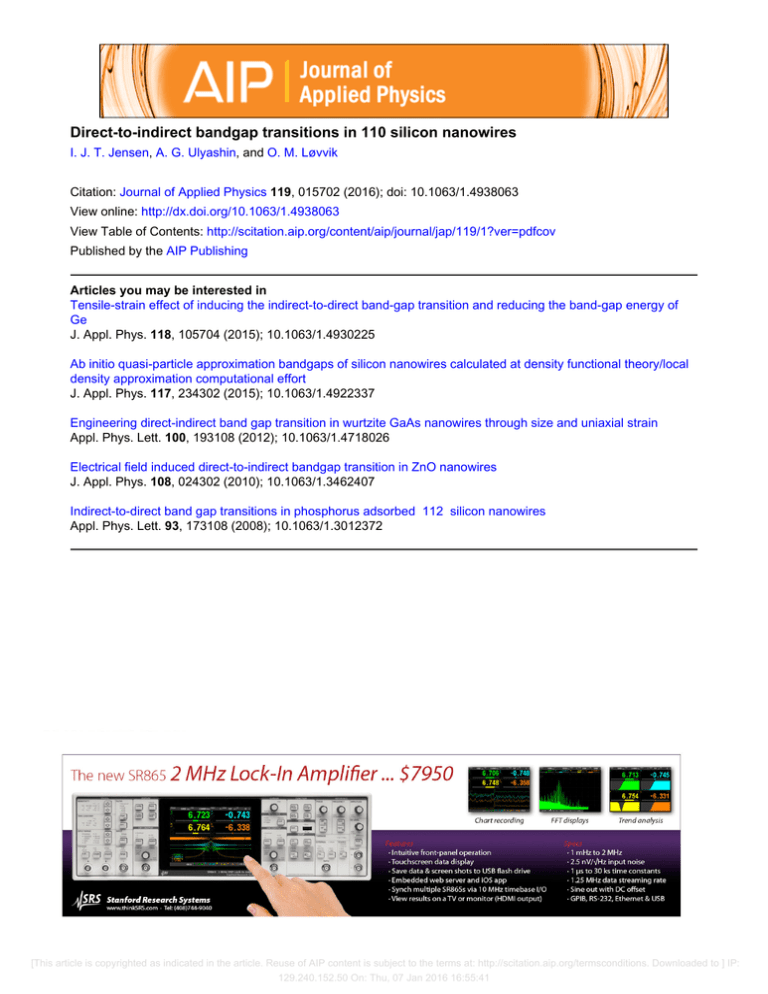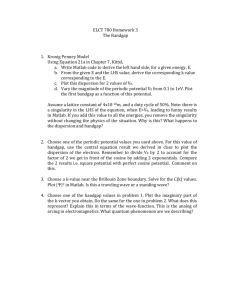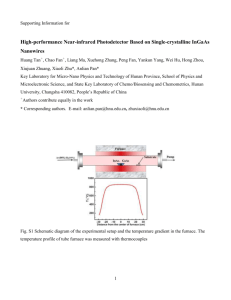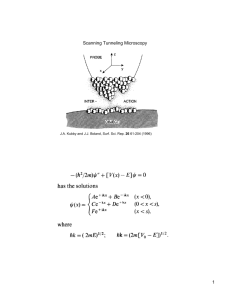Direct-to-indirect bandgap transitions in 110 silicon nanowires
advertisement

Direct-to-indirect bandgap transitions in 110 silicon nanowires I. J. T. Jensen, A. G. Ulyashin, and O. M. Løvvik Citation: Journal of Applied Physics 119, 015702 (2016); doi: 10.1063/1.4938063 View online: http://dx.doi.org/10.1063/1.4938063 View Table of Contents: http://scitation.aip.org/content/aip/journal/jap/119/1?ver=pdfcov Published by the AIP Publishing Articles you may be interested in Tensile-strain effect of inducing the indirect-to-direct band-gap transition and reducing the band-gap energy of Ge J. Appl. Phys. 118, 105704 (2015); 10.1063/1.4930225 Ab initio quasi-particle approximation bandgaps of silicon nanowires calculated at density functional theory/local density approximation computational effort J. Appl. Phys. 117, 234302 (2015); 10.1063/1.4922337 Engineering direct-indirect band gap transition in wurtzite GaAs nanowires through size and uniaxial strain Appl. Phys. Lett. 100, 193108 (2012); 10.1063/1.4718026 Electrical field induced direct-to-indirect bandgap transition in ZnO nanowires J. Appl. Phys. 108, 024302 (2010); 10.1063/1.3462407 Indirect-to-direct band gap transitions in phosphorus adsorbed 112 silicon nanowires Appl. Phys. Lett. 93, 173108 (2008); 10.1063/1.3012372 [This article is copyrighted as indicated in the article. Reuse of AIP content is subject to the terms at: http://scitation.aip.org/termsconditions. Downloaded to ] IP: 129.240.152.50 On: Thu, 07 Jan 2016 16:55:41 JOURNAL OF APPLIED PHYSICS 119, 015702 (2016) Direct-to-indirect bandgap transitions in h110i silicon nanowires I. J. T. Jensen,1,a) A. G. Ulyashin,1 and O. M. Løvvik1,2 1 SINTEF Materials and chemistry, P/O box 124 Blindern, 0314 Oslo, Norway Department of Physics, University of Oslo, P/O box 1048 Blindern, 0316 Oslo, Norway 2 (Received 14 October 2015; accepted 4 December 2015; published online 7 January 2016) The bandstructure of h110i silicon nano wires (SiNWs) with diameters (d) up to 6.1 nm were studied using density functional theory. Three types of surface termination were investigated: H, F, and OH; all giving quantum confinement induced direct bandgaps in the investigated size range. Comparison of the calculated results to reported experimental values showed that trends in the bandstructure behaviour were well reproduced. By studying the relative decrease of global and local minima in the conduction band minimum with increasing d, it was possible to predict a direct-to-indirect bandgap transition at d ¼ 9.2, 9.5, and 11.4 nm for H, F, and OH terminated NWs, respectively. C 2016 AIP Publishing LLC. [http://dx.doi.org/10.1063/1.4938063] V I. INTRODUCTION As the quest to fulfil Moore’s law continues to push the physical limits of conventional electronic devices, semiconductor nanowires have attracted attention due to their potential for high-performance nanoscale devices. Among the advantages of silicon nanowires (SiNWs) are the high surface-tovolume ratio and the compatibility with established Si-based technology, in particular. The most intriguing property of SiNWs, however, is related to their 1D nature, which results in a quantum confinement induced direct bandgap. The quantum confinement aspect of SiNWs has been studied theoretically for more than twenty years,1 while experimentally, research on SiNWs dates back to the late 1950s.2 However, SiNWs have seen a rapid increase in interest during the last decade. At present, single-crystal SiNWs with diameters approaching molecular dimensions can be produced in a controlled manner,3 while improved computational power has made it possible to calculate the properties of SiNWs with increasingly large diameters. The advantage of using computational methods is the possibility to study a large selection of growth directions, cross-section geometries, and terminating species for SiNWs. In particular, the h001i and h110i growth directions have received attention.4–9 Nolan et al. compared the bandstructure of H and OH-terminated h001i SiNWs with diameters below 2 nm and found that the functional group used to terminate the Si dangling bonds significantly modifies the band gap, with a decrease in band gap up to 1 eV when replacing H with OH. Gao et al. compared h001i and h110i SiNWs with F and SiO2-like termination for diameters up to about 3 nm. For the h110i SiNWs, the bandgap vs. 1/d behaviour of the H- and F-terminated models were similar, approaching the bandgap of bulk Si for d approaching infinity. The SiO2-like termination, however, was found to induce strain, which was drastically reducing the bandgap relative to 1/d. The effect of surface passivation and orientation on the electric properties of SiNWs were also explored by Zhuo et al.,8 who investigated the band structure of h001i and a) IngvildThue.Jensen@sintef.no 0021-8979/2016/119(1)/015702/5/$30.00 h110i SiNWs with H, F, and CH3 passivation for diameters below 3.4 nm. The h110i SiNWs were found to be more influenced by their surface termination than h001i SiNWs. In this work, the effects of surface passivation and diameter on the bandstructure of h110i Si NWs are studied using density functional theory (DFT). Comparisons of bandgaps and bandstructure are made for H, F, and OH terminated h110i SiNWs with diameters up to 6.1 nm, and the calculated results are used to predict the SiNW diameter for directto-indirect transition. II. METHODS DFT calculations at the PBE-GGA level, i.e., using the Perdew-Burke-Ernzerhof generalized gradient approximation for the exchange-correlation energy,10 were performed using the Vienna ab-initio simulation package (VASP).11,12 Silicon nanowires with diameters ranging from 1.2 to 5.8 nm (without terminating species) were modelled in the Si h110i growth direction. The h110i orientation was chosen as this has been reported in the literature to be the preferred growth direction experimentally for silicon NWs in this size range.3,13 A hexagonal shape with f111g and f001g facets was used in close compliance with experimental reports.3,14 The NWs were modelled in the middle of a supercell with dimensions a b c, where b ¼ 3.86 Å and a and c were large enough to allow 20 Å vacuum between the NWs. Surface passivation with different terminating species was investigated, namely, H, F, and OH. Figure 1 shows the input model for the largest calculated NW, and details of all the models can be found in Table I. For the calculations, the plane-wave energy cut-off was 400 eV and a 1 9 1 Gamma sampling of k-points was used to model the Brillouin zone. The chosen energy cut-off and k-point values gave a convergence in the calculated band gaps better than 0.01 eV. Structural optimizations of the atomic positions were performed with the break condition for the relaxation loop set to forces <0.01 eV/Å. Due to the vacuum included in the unit cell, this meant that the structure was allowed to expand or contract in the a and c directions, while the growth direction (b) was kept constant. Relaxation 119, 015702-1 C 2016 AIP Publishing LLC V [This article is copyrighted as indicated in the article. Reuse of AIP content is subject to the terms at: http://scitation.aip.org/termsconditions. Downloaded to ] IP: 129.240.152.50 On: Thu, 07 Jan 2016 16:55:41 015702-2 Jensen, Ulyashin, and Løvvik J. Appl. Phys. 119, 015702 (2016) double, and triple in the b-direction. For H termination, the results did not show any structural irregularities on a scale larger than b, thus the single a b c supercell was judged sufficiently large to give a representative picture of surface passivation of silicon NWs using H and F. The latter was based on the very similar behaviour of H and F as passivating species, as will be shown. The case of OH-termination is more complicated and will be discussed later. III. RESULTS AND DISCUSSION A. Bandgaps as a function of diameter FIG. 1. Cross-sectional view of the largest h110i NW model before relaxation. Large atoms represent Si, while small atoms represent the termination, i.e., H, F, or OH. The black atoms in the middle show the cross section of the smallest NW. The NW has two different types of surfaces, f001g and f111g. The diameter (d) is defined as the largest distance across the NW, excluding the termination. of the b axis was also tested for a selection of models but did not seem to impact the bandgaps to any significant extent. After structural relaxation, the electron density was calculated to an electronic convergence less than 105 eV change in the total energy. Finally, band structure calculations were performed along the direction in k-space corresponding to the planes in the NW growth direction, keeping the electron density from the previous step constant. 25 k-points were used for the 1.2–4.3 nm diameter models and 15 k-points for the 5 and 5.8 nm diameter models. Diameters were defined as the largest distance across the NW cross section before structural relaxation, not including terminating species. This was chosen for the sake of comparison between models with different terminating species. When terminating species are included, which is often the case in the literature, the largest models calculated in this work have diameters of 6 and 6.1 nm for H and F termination, respectively. First principles based molecular dynamics (MD) as implemented in VASP was performed on H and OH terminated NWs with 1.2 nm diameter to investigate how the periodicity in the growth direction affects the arrangement of the terminating species. The MD calculations were done at 300 K for 1000 cycles of 1 fs. Both MD and DFT calculations were done for 1.2 nm diameter supercells which were single, Table I lists the bandgaps calculated for each NW model. Figure 2 shows the calculated bandgaps Eg as a function of the inverse diameter (1/d) for H, F, and OH surface termination. The corresponding calculation for bulk Si is included as a horizontal line to offer a point of reference, as DFT tends to underestimate bandgaps. In general, the bandgap decreases with the increase in diameter. The largest bandgaps are seen for H terminated NWs with small diameters. Both H and F terminations give a linear dependence of the inverse diameter. H termination results in a steeper slope than Ftermination, both reaching a value about 0.1 eV below bulk Si for 1/d ¼ 0. Although commonly used, the bulk bandgap of Si might not be the most relevant value for comparison with h110i NWs. This will be discussed in Section III C. The behaviour of OH-terminated NWs is more irregular. On average, the bandgaps follow a line with slope similar to that of H terminated NWs, about 0.5 eV below. However, for OH larger deviations are found from the line, in a seemingly random manner. The bandgaps for diameters approaching infinity drop well below the value of bulk Si. This was seen previously for SiO2-like terminated NWs, where it was taken as an indication of strain.5 This and the irregular behaviour of OH terminated NWs raise questions about whether the ideal OH positions have been found. To investigate the position of the OH molecule, both MD and DFT were performed on 1.2 nm diameter supercells which were single, double, and triple in the b-direction. MD TABLE I. NW models with calculated bandgaps for different diameters and terminating species (X). The bandgaps are all direct. The listed diameters do not include the terminating species. Model Diameter (nm) 1.2 1.9 2.7 3.5 4.3 5.0 5.8 Calculated bandgaps (eV) #Si atoms #X atoms X¼H X¼F X ¼ OH 24 54 96 150 216 294 384 16 24 32 40 48 56 64 1.73 1.25 1.03 0.92 0.87 0.78 0.77 1.24 0.95 0.84 0.78 0.73 0.70 0.68 1.27 0.74 0.84 0.51 0.44 0.53 0.27 FIG. 2. Calculated bandgaps as a function of the inverse diameter (1/d). The calculated bandgap for bulk Si is included as a horizontal line to offer a point of reference, as DFT tends to underestimate bandgaps. Also included are experimental results for H terminated f110g SiNWs from the work of Ma et al.14 [This article is copyrighted as indicated in the article. Reuse of AIP content is subject to the terms at: http://scitation.aip.org/termsconditions. Downloaded to ] IP: 129.240.152.50 On: Thu, 07 Jan 2016 16:55:41 015702-3 Jensen, Ulyashin, and Løvvik was conducted under the same conditions as described previously for H termination. The resulting structures were rather chaotic, giving no clear indications as to what would be the preferred positions for the OH molecule. The DFT calculations, on the other hand, gave highly ordered structures, showing no irregularities on a scale larger than b. The deviations from linear dependence of Eg on 1/d for OH terminated NW models point to an increase in complexity when using molecules rather than single atoms to terminate SiNW surfaces. From the particle-in-a-box analogy, the band gap is expected to scale linearly with 1/d2, rather than 1/d as seen above. A limitation of the particle-in-a-box model, however, is the disregard of surface and surroundings. Previously, it has been argued that so-called self-energy corrections, which J. Appl. Phys. 119, 015702 (2016) arise from dielectric mismatch between the NWs and their surroundings, will add an additional 1/d dependence.15 Others have reported a phenomenological dependence of Eg upon the surface-to-volume ratio, highlighting the importance of surface in semiconducting NW systems.6 Experimental results for H terminated f110g SiNWs have been added to Figure 2 for comparisons. The experimental band gaps are taken from the work of Ma et al. and were measured using scanning tunneling spectroscopy.14 For SiNWs with d 2.5 nm, the calculated and experimental bandgaps as a function of inverse diameter are in good correspondence, following similar slopes. The underestimation of the bandgaps caused by DFT turns out to be near constant in this range, which makes it possible to reproduce trends in the system even if the absolute values of the calculated bandgaps FIG. 3. Examples of bandstructure for NW with different diameters (d) and termination. All terminated NWs calculated in this work exhibit a direct bandgap in C, which decreases in magnitude with increasing d. In addition, all structures have a local minimum in the conduction band (Rmin) just below k ¼ 0.7 Å1. [This article is copyrighted as indicated in the article. Reuse of AIP content is subject to the terms at: http://scitation.aip.org/termsconditions. Downloaded to ] IP: 129.240.152.50 On: Thu, 07 Jan 2016 16:55:41 015702-4 Jensen, Ulyashin, and Løvvik FIG. 4. Calculated bandstructure along the Si h110i direction for H-terminated NWs with 1.2 and 5 nm diameters (red and black, respectively). C marks the CBM and Rmin marks the local CB minimum along the R direction. J. Appl. Phys. 119, 015702 (2016) this evolvement towards indirect bandgap. In Figure 5, the direct bandgap has been plotted as a function of 1/d for H, F, and OH termination. Also included is the energy difference between the local CB minimum Cmin and the valence band maximum (VBM), labelled indirect bandgap. For all terminating species, both direct and indirect bandgaps are found to vary linearly with 1/d. For OH, the linearity becomes clearer if looking at the relative energy difference between the global and the local CB minima, see Figure 5(d). From extrapolation, a transition from direct to indirect bandgap is found to occur at d ¼ 9.2, 9.5, and 11.4 nm for H, F, and OH termination, respectively. This indicates that OH termination preserves a direct bandgap for slightly larger diameters than H and F. C. The effect of NW surfaces are too small compared to experimentally obtained results. For SiNWs with d 2.5 nm, the limitations of the computational method are becoming apparent as the exchangecorrelation functionals will struggle to capture the confinement at this scale. B. Band structure—Direct versus indirect bandgap Figure 3 shows the calculated band structure along the growth direction for d ¼ 1.2, 2.7, and 4.3 nm. All the calculated models with H, F, and OH termination exhibit a direct bandgap at C. In addition to the conduction band minimum (CBM) at C, a local minimum (Rmin) is seen in the conduction band just below k ¼ 0.7 Å1. The energy difference between this local minimum and the CBM decreases with increasing d, i.e., the NW bandgap character goes towards indirect as the diameter increases. Figure 4 shows an enhanced view of the conduction band for the H-terminated NWs with the smallest and the largest diameter, highlighting Figure 6 shows parts of the band diagram for bulk Si calculated using the same level of DFT as for the Si NW investigation. The left part of Figure 6 shows the D direction where the CBM is found, while the right part of the figure shows the R direction, which corresponds to the growth direction of the Si NWs. As can be seen, the R direction for bulk Si has an indirect bandgap with the CBM in the region corresponding to the local (indirect) CBM found for the SiNWs. Thus, the transition from direct to indirect bandgap predicted from Figure 5 might be a result of quantum confinement coming to an end. The size of the indirect bandgap along the R direction in Figure 6, however, is far greater than the values calculated for the largest SiNWs. Thus, the evolvement of the bandgap from quantum confined NW towards bulk Si is not quite as simple as one might lead to believe from representations such as Figure 2, where the direct bandgaps of the NWs are compared directly to the indirect bandgap of bulk Si. FIG. 5. Calculated difference between VBM and CBM (labeled direct) and between VBM and local CB minimum Cmin (labeled indirect), as a function of inverse diameter (1/d). (a) H termination, (b) F termination, and (c) OH termination. The data are extrapolated to find the transition from direct to indirect bandgap. In (d) the difference between CBM and local minimum Cmin is plotted for the NWs with OH termination, to better illustrate the linearity. [This article is copyrighted as indicated in the article. Reuse of AIP content is subject to the terms at: http://scitation.aip.org/termsconditions. Downloaded to ] IP: 129.240.152.50 On: Thu, 07 Jan 2016 16:55:41 015702-5 Jensen, Ulyashin, and Løvvik J. Appl. Phys. 119, 015702 (2016) FIG. 6. Parts of the band diagram for bulk Si calculated using the same level of DFT as for the Si NW investigation: The D direction where the CBM is found (left) and the R direction, which corresponds to the growth direction of the h110i Si NWs in this work (right). In the latter, the k axis is reversed compared to the convention, in order to compare directly to the NW bandstructure plots. A complicating aspect that must be taken into account is the effect of the terminating species on the surface of the NWs. While quantum confinement facilitates a direct bandgap which increases as the diameter of the NW decreases, the Si dangling bonds on the NW surface act to destroy the bandgap altogether. The unpaired valence electrons at the SiNW surface form electrically active traps with energies in the Si bandgap. This is remedied to a certain extent by introducing terminating species such as H, F, or OH. As seen above, however, the bandgaps of the surface terminated NWs are smaller than the bandgaps of bulk Si. To investigate the effect of surface, two different models were constructed: a f001g surface model and a f111g surface model, both terminated by H. For each model, two Si layer thicknesses were calculated, corresponding to the distance between the planes in the smallest and the largest NW. The bandstructure in the NW growth direction is shown in Figure 7(a) for the f111g surface model and (b) for the f001g surface model. As can be seen, the f001g surface model exhibits a quantum confinement induced direct bandgap, while the bandgap of the f111g surface model was found to be indirect for both model thicknesses. This corresponds well to recent results for ultra-thin Si films from Lin et al.16 and shows how different surface orientations give rise to different quantum confinement effects in the same material. IV. CONCLUSIONS The bandstructure of h110i SiNWs with different diameters and terminating species was studied using DFT at the PBE-GGA level. Comparison to existing experimental values14 demonstrated that it is possible to use DFT at this level to predict trends in the bandstructure behaviour. The bandgaps were found to decrease linearly with 1/d, and F and OH terminations were found to reduce the bandgap compared with H termination for NWs with equivalent d. A local minimum in the CB was observed to decrease more rapidly with increasing d than the CBM. By looking at the relative difference between the CBM and this local minimum, it was FIG. 7. Calculated bandstructure in the 110 direction for Si f001g and f111g surface models ((a) and (b), respectively) with thicknesses corresponding to the largest and the smallest Si NWs studied in this work. possible to predict a direct-to-indirect bandgap transition at d ¼ 9.2, 9.5, and 11.4 nm for H, F, and OH termination, respectively. ACKNOWLEDGMENTS The authors are grateful for the financial support of the European project nanoPV in the framework of FP7-Energy2009-2.1.1, Grant No. 241281. 1 A. J. Read, R. J. Needs, K. J. Nash, L. T. Canham, P. D. J. Calcott, and A. Qteish, Phys. Rev. Lett. 69, 1232 (1992). 2 R. G. Treuting and S. M. Arnold, Acta Metall. 5, 598 (1957). 3 Y. Wu, Y. Cui, L. Huynh, C. J. Barrelet, D. C. Bell, and C. M. Lieber, Nano Lett. 4, 433 (2004). 4 M. Nolan, S. O’Callaghan, G. Fagas, and J. C. Greer, Nano Lett. 7, 34 (2007). 5 M. Gao, S. You, and Y. Wang, Jpn. J. Appl. Phys., Part 1 47, 3303 (2008). 6 D. Yao, G. Zhang, and B. Li, Nano Lett. 8, 4557 (2008). 7 M.-F. Ng, L. Y. Sim, H. Da, H. Jin, K. H. Lim, and S.-W. Yang, Theor. Chem. Acc. 127, 689 (2010). 8 K. Zhuo and M.-Y. Chou, J. Phys.: Condens. Matter 25, 145501 (2013). 9 D. B. Migas and V. E. Borisenko, J. Appl. Phys. 104, 024314 (2008). 10 J. P. Perdew, J. A. Chevary, S. H. Vosko, K. A. Jackson, M. R. Pederson, D. J. Singh, and C. Fiolhais, Phys. Rev. B 46, 6671 (1992). 11 G. Kresse and J. Furthm€ uller, Phys. Rev. B 54, 11169 (1996). 12 G. Kresse and J. Furthm€ uller, Comput. Mater. Sci. 6, 15 (1996). 13 V. Schmidt, J. V. Wittermann, and U. G€ osele, Chem. Rev. 110, 361 (2010). 14 D. D. D. Ma, C. S. Lee, F. C. K. Au, S. Y. Tong, and S. T. Lee, Science 299, 1874 (2003). 15 Y. M. Niquet, A. Lherbier, N. H. Quang, M. V. Fernandez-Serra, X. Blase, and C. Delerue, Phys. Rev. B 73, 165319 (2006). 16 L. Lin, F. Li, J. Feng, and Z. Zhang, Phys. Chem. Chem. Phys. 15, 6063 (2013). [This article is copyrighted as indicated in the article. Reuse of AIP content is subject to the terms at: http://scitation.aip.org/termsconditions. Downloaded to ] IP: 129.240.152.50 On: Thu, 07 Jan 2016 16:55:41





